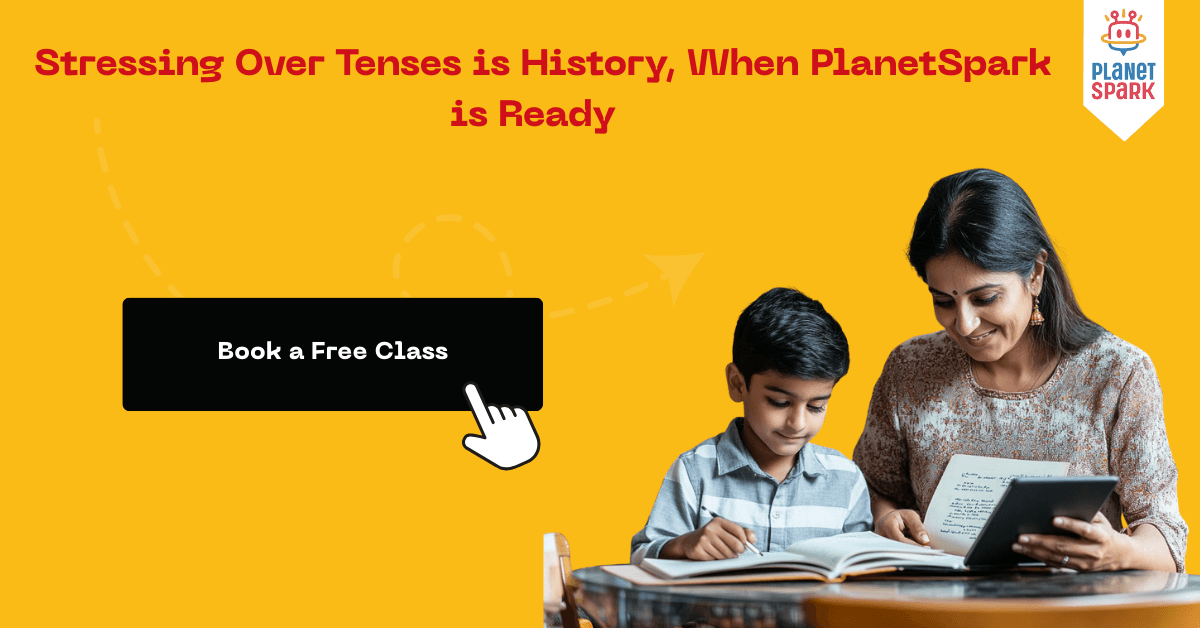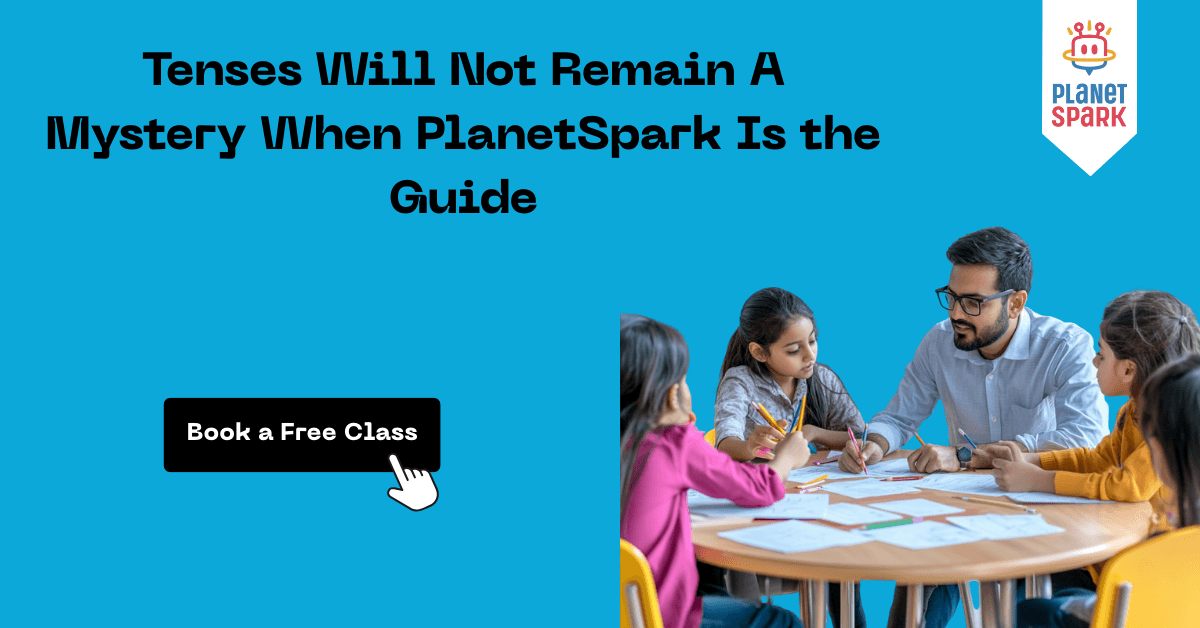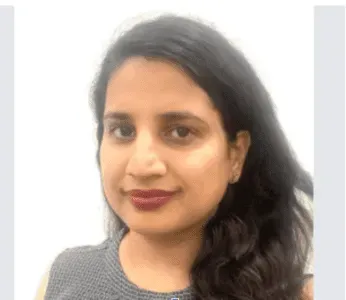Tenses for Kids Class 2: Grammar Rules & Examples

English grammar is the cornerstone of effective communication, and tenses are one of its most essential elements. For children in Class 2, learning how and when actions happen in relation to time is vital. Tenses enable kids to articulate thoughts clearly, narrate their experiences, and participate in meaningful conversations. From simple sentence formation to describing routines or recalling past events, mastering tenses at this stage helps strengthen fluency and writing precision. This guide aims to offer a clear understanding of tenses through definitions, examples, and engaging strategies.
PlanetSpark’s Grammar Course for Kids complements this learning journey by simplifying grammar through interactive lessons and gamified exercises. The program offers 1:1 mentoring, personalised learning paths, and AI-powered tools to provide real-time feedback on tense usage and grammar skills. Children are not only guided through past, present, and future tenses but also receive structured practice and assessments that ensure lasting retention and confident communication.
What Are Tenses?
Tenses refer to the form of verbs that help describe actions in relation to time. They indicate whether an action took place in the past, is happening in the present, or will occur in the future. These grammatical tools allow speakers to align the timing of events and provide context to actions.
There are three main types of tenses:
- Present Tense
- Past Tense
- Future Tense
Each of these is further divided into four forms:
- Simple
- Continuous (also called Progressive)
- Perfect
- Perfect Continuous
When students learn how these tenses function together, they build the foundation for expressing events in a logical and coherent manner. Mastering these forms gives children the tools to communicate effectively and express events with clarity.

Present Tense for Class 2
The present tense is used to describe actions that are happening now, general truths, or routines. This is often the first tense children learn since it applies to most of their everyday activities.
1. Simple Present Tense
This tense is used to express habits, general truths, and fixed arrangements.
Examples:
- The sun rises in the east.
- I go to school every day.
- He plays football.
This tense is ideal for teaching regular actions and universal facts. Children can relate this tense to their daily routine.
Want your child to understand sentence construction effortlessly? Try PlanetSpark’s Grammar Courses today!
2. Present Continuous Tense
Used for actions happening at the moment of speaking.
Examples:
- I am reading a book.
- She is dancing.
- They are watching TV.
It teaches children to observe what’s going on around them and express it grammatically.
3. Present Perfect Tense
Describes actions that occurred at an unspecified time but are relevant to the present.
Examples:
- I have eaten lunch.
- She has completed her homework.
It emphasizes results or outcomes and allows kids to share experiences.
4. Present Perfect Continuous Tense
Used to show that an action started in the past and is still ongoing.
Examples:
- I have been reading for two hours.
- He has been playing since morning.
This form introduces the idea of time span and continuity.
Past Tense for Class 2
The past tense talks about actions that already happened. It helps children narrate stories, describe experiences, or recall previous events.
1. Simple Past Tense
Refers to actions completed in the past.
Examples:
- She went to school.
- I ate my lunch.
A great way to reinforce this tense is by asking students to describe what they did yesterday.
2. Past Continuous Tense
Describes past actions that continued for a period of time.
Examples:
- I was reading when the bell rang.
- They were playing football.
This encourages children to describe events with context and additional detail.
Struggling with past tense rules? Let PlanetSpark’s Grammar Courses make it simple and fun for your child.
3. Past Perfect Tense
Shows that an action was completed before another took place in the past.
Examples:
- The bus had left before I reached.
- She had finished dinner before the guests arrived.
Useful for storytelling and sequencing events.
4. Past Perfect Continuous Tense
Used for an action that began in the past and continued up to another past moment.
Examples:
- He had been working all night.
- I had been waiting for hours.
Children understand how to connect two events using time markers.
Future Tense for Class 2
Future tense helps children plan or predict events. It builds their ability to express expectations, intentions, and probabilities.
1. Simple Future Tense
Talks about actions that will happen.
Examples:
- I will visit my grandmother tomorrow.
- She will call you.
Teaches them how to express upcoming plans or intentions.
2. Future Continuous Tense
Describes an action that will be ongoing at a future time.
Examples:
- I will be studying at 8 PM.
- They will be playing cricket.
Encourages time planning and forecast expression.
3. Future Perfect Tense
Refers to actions that will be completed before a specific time in the future.
Examples:
- I will have finished my homework by 5 PM.
- She will have left by the time we arrive.
Make sure your child is future-ready, explore PlanetSpark’s Grammar Courses now!
4. Future Perfect Continuous Tense
Describes actions that will continue up to a point in the future.
Examples:
- By next month, I will have been working here for a year.
- She will have been traveling for two weeks.

How To Teach Tenses to Class 2 Students
Teaching grammar to second graders can be enjoyable and effective with the right strategies. Here are some proven methods:
1. Use Real-life Examples
Relate sentence formation to daily activities to make learning relatable.
Example: "I am brushing my teeth."
2. Interactive Games
Use grammar games, apps, and quizzes to make learning fun. These help children retain concepts through repetition.
3. Reading Practice
Encourage reading storybooks and poems. This helps children observe tense usage naturally and builds vocabulary.
4. Sentence Construction Activities
Provide jumbled words and ask them to form correct sentences in specific tenses. Let them create their own sentences to improve confidence.
Unlock your child's potential in grammar, book a free demo of PlanetSpark's Grammar Courses today!
5. Online Grammar Classes
Enroll in interactive platforms like PlanetSpark for guided, engaging lessons. The structure and feedback help solidify tense understanding.
Why PlanetSpark is the Best Platform to Learn Tenses
PlanetSpark combines technology, experienced trainers, and interactive tools to make learning grammar accessible and fun for young learners.
1. 1:1 Personal Trainers for Every Child
Every child is paired with a certified communication expert who delivers fully personalised, one-on-one live classes. These trainers:
- Understand the child’s learning style and pace
- Offer instant feedback
- Help build skills in grammar, storytelling, creative writing, and more
2. Personalised Curriculum and Roadmap
No two students learn the same way. That’s why PlanetSpark offers:
- Skill assessments to pinpoint grammar gaps
- A learning roadmap designed for steady progress
- Regular updates based on milestones and trainer feedback
3. SparkX – AI-Enabled Video Analysis Tool
This tool analyses children's recorded videos and provides insights on:
- Voice clarity and grammar
- Body language
- Sentence structure
4. AI-Led Practice Sessions
PlanetSpark offers AI-powered sessions to:
- Simulate real-world speaking situations
- Provide instant grammar and fluency feedback
- Enhance independent learning
5. Spark Diary – Daily Digital Journal
Helps students:
- Practise writing regularly
- Enhance thought clarity and grammar usage
- Reflect on daily learning
6. Gamified Learning Experience
Make learning grammar fun with:
- Grammar Guru Challenge
- Vocabulary quizzes
- Spell Knockout
7. Parent-Teacher Meetings (PTMs)
Regular PTMs ensure parents are involved and aware of their child’s grammar and language development.
8. Comprehensive Progress Reports
Parents get reports covering:
- Grammar and syntax
- Confidence and delivery
- Sentence structure and vocabulary
9. Learning Clubs and Communities
Clubs include:
- Story Writing
- Debate
- Poetry
- Podcasting These give students real-life exposure and collaborative learning opportunities.
10. Sparkline – Safe Content Sharing for Kids
A monitored platform where kids can:
- Share speeches, stories, and poems
- View peer content and get motivated
11. Contests and Recognition Events
Regular activities like:
- Storytelling competitions
- Public speaking challenges
- Creative writing contests Boost motivation and confidence.
12. SparkBee: Grammar & Vocabulary Fun
A kid-friendly quiz game that:
- Tests grammar, spelling, and vocabulary
- Offers rewards and makes learning joyful
13. SparkShop: Digital eBooks for All Grades
- Fun, interactive books on grammar and writing
- Budget-friendly and easy to access
Conclusion
Understanding tenses is the first big step for children to master English. For Class 2 students, learning grammar tenses doesn’t have to be boring. With the right techniques and engaging platforms like PlanetSpark, students can build a strong language foundation while enjoying the process.
Tenses are essential to reading, writing, listening, and speaking. Building these skills at a young age equips children with tools for lifelong communication success. Encourage your child to apply grammar in daily conversation and creative writing, and watch their confidence soar.
Want your child to master tenses and grammar? BOOK a FREE Class with PlanetSpark NOW!
FAQs About Tenses for Kids for Class 2
1. How do we use tenses in everyday life? We use tenses in daily conversations and writings to express when things happen. Whether telling a story or describing our day, tenses help organize our thoughts.
2. Why are tenses important? They help express ideas accurately. Proper tense usage is crucial for correct sentence formation and communication.
3. What are the three main types of tenses? Past, Present, and Future. Each has four sub-types: Simple, Continuous, Perfect, and Perfect Continuous.
4. Which is the most used tense? The simple present tense is most commonly used in daily conversations.
5. Can tenses be changed mid-sentence? Only if the action's time context changes. Unplanned changes confuse the reader or listener.
6. How can I make my child confident in using tenses? Practice, online classes, and regular reading help build confidence in using tenses.
7. Is it possible to learn tenses through online platforms? Yes! Platforms like PlanetSpark offer personalised lessons, AI feedback, and games that make tense learning effective and fun.
Personalized Communication Report
Record a video to get a AI generated personalized communication report for your child

Hi There, want to try these
tips for your child with
LIVE with our expert coach?
Let's check your child's
English fluency
